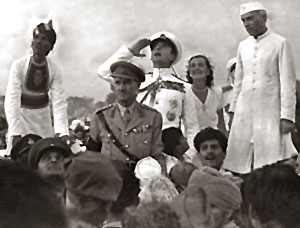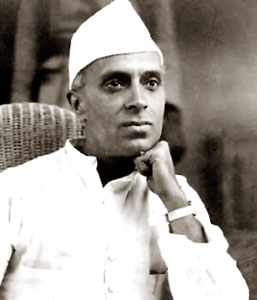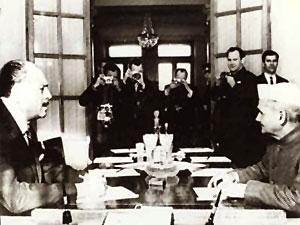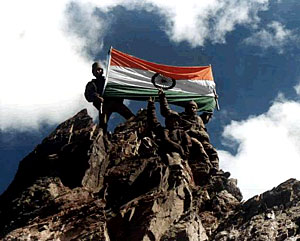Military Operations of Indian Army:
The Indian Army has carried over a large number of
military operations in order to safeguard the country`s territory and
also to restrain the enemies from causing any damage to India. Almost
all the military operations of Indian Army so far have seen considerable
success and the Indian soldiers did not step back from the battlefield
even in front of the toughest situation.
Some of the noticeable military operations of Indian Army are narrated below:
The First Kashmir War
 Tensions between India and Pakistan began to boil over, almost
immediately after independence. The first of the three wars fought
between India and Pak broke out over the then princely state of Kashmir.
The Maharaja Hari Singh of Kashmir was not showing any interest in
signing a treaty either with India or Pakistan and as a result, an
impatient Pakistan sponsored a `tribal` invasion of parts of Kashmir.
Soon after that incident, Pakistan also sent in its troops to capture
Kashmir. Afraid of the incidence, the Maharaja Hari Singh appealed to
India and also to the Governor General, Lord Mountbatten and sought
help. However, it was pointed out to him that India saw no reason to do
so. Under pressure, he signed the Instrument of Accession (agreement)
and Kashmir was unilaterally merged with India. Though the decision got
approval from Britain, Pakistan never accepted it and immediately after
this, Indian troops were airlifted into Srinagar. The Indian soldiers
initially faced tough opposition from the invaders and were also driven
back. An intense war engaged across the state and former comrades found
themselves fighting each other. Both India and Pakistan made some
territorial gains and also suffered significant losses. One-third part
of Kashmir was captured by the Pakistani troops and that part is known
as Azad-Kashmir, at present. An apprehensive UN sponsored peace was sent
back by the end of 1948 and the Indian and Pakistani soldiers were
facing each other directly on the Line of Control. Since then, the Line
of Control has been the division line between India and the Pakistani
held Kashmir.
Tensions between India and Pakistan began to boil over, almost
immediately after independence. The first of the three wars fought
between India and Pak broke out over the then princely state of Kashmir.
The Maharaja Hari Singh of Kashmir was not showing any interest in
signing a treaty either with India or Pakistan and as a result, an
impatient Pakistan sponsored a `tribal` invasion of parts of Kashmir.
Soon after that incident, Pakistan also sent in its troops to capture
Kashmir. Afraid of the incidence, the Maharaja Hari Singh appealed to
India and also to the Governor General, Lord Mountbatten and sought
help. However, it was pointed out to him that India saw no reason to do
so. Under pressure, he signed the Instrument of Accession (agreement)
and Kashmir was unilaterally merged with India. Though the decision got
approval from Britain, Pakistan never accepted it and immediately after
this, Indian troops were airlifted into Srinagar. The Indian soldiers
initially faced tough opposition from the invaders and were also driven
back. An intense war engaged across the state and former comrades found
themselves fighting each other. Both India and Pakistan made some
territorial gains and also suffered significant losses. One-third part
of Kashmir was captured by the Pakistani troops and that part is known
as Azad-Kashmir, at present. An apprehensive UN sponsored peace was sent
back by the end of 1948 and the Indian and Pakistani soldiers were
facing each other directly on the Line of Control. Since then, the Line
of Control has been the division line between India and the Pakistani
held Kashmir.
Goa, Daman and Diu Operation (1961)
This operation was held in 1961 with a view to clear the Portuguese people from the three places of Goa, Daman and Diu. Though India got its Independence in 1947, those three areas were being captured by the Portuguese till 1961. The Indian government did request the Portuguese people to empty the areas repeatedly till 1961 and the Portuguese had refused the request every time. To this, the government of India ordered a small group of trusted military troops to evacuate the Portuguese territories and secure them. The operation was named as the Goa Operation, 1961. The Portuguese soldiers were soon stormed by the Indian soldiers and unable to bear the assault, the Portugal government signed a treaty with India. It also restrained its control over the small territories, which formally became part of the Indian Union.
The Indo-China Conflict- 1962
 The Indian Police posts had been pushed forward into territory claimed
by the Chinese Government, since 1959 and there had been some small
scale clashes between India and China for that reason. The small clashes
soon became bigger and India and China engaged with each other in a
fierce war. The Indian government insisted that the border ran along the
"traditional" watershed, in effect the McMahon Line and China
challenged this. After the attempts of making peace by discussions
remained fruitless, the Indian government ordered the Indian soldiers to
move to the Thagla Plain near the border between Bhutan and Arunachal
Pradesh, in 1962. The border formed part of the watershed, though it was
some three miles to the north of the McMahon line. The tensions between
the two countries increased when India came to know that the Chinese
government had constructed a road through Aksai Chin which India
claimed. The Chinese soldiers made a surprise attack on the Indian
soldiers in September 1962 by using aero planes. Surprised and angered
with this incident, the then Prime Minister of India, Pundit Jawaharlal
Nehru issued an order on October 12, and asked the soldiers to evacuate
the Chinese from Aksai Chin.
The Indian Police posts had been pushed forward into territory claimed
by the Chinese Government, since 1959 and there had been some small
scale clashes between India and China for that reason. The small clashes
soon became bigger and India and China engaged with each other in a
fierce war. The Indian government insisted that the border ran along the
"traditional" watershed, in effect the McMahon Line and China
challenged this. After the attempts of making peace by discussions
remained fruitless, the Indian government ordered the Indian soldiers to
move to the Thagla Plain near the border between Bhutan and Arunachal
Pradesh, in 1962. The border formed part of the watershed, though it was
some three miles to the north of the McMahon line. The tensions between
the two countries increased when India came to know that the Chinese
government had constructed a road through Aksai Chin which India
claimed. The Chinese soldiers made a surprise attack on the Indian
soldiers in September 1962 by using aero planes. Surprised and angered
with this incident, the then Prime Minister of India, Pundit Jawaharlal
Nehru issued an order on October 12, and asked the soldiers to evacuate
the Chinese from Aksai Chin.
However, the Chinese Army soon made a double-way attack on India through both the North-West and North-East parts of the border on October 20 and also entered the disputed Aksai Chin region along with Arunachal Pradesh in numbers. After invading into the area, the Chinese government called on the Indian government for negotiation. However, none of the countries could get into any peaceful agreement or settlement and China unilaterally withdrew their troops from the territory they had occupied. There are some disputes about the reasons for the withdrawal, as India claims that logistical problems and diplomatic support from the US forced China to do so. On the other hand, China states that it was returning to the borders that it had diplomatically claimed. The dividing line between the Indian and Chinese forces was positioned the Line of Actual Control. The Indian government also set up a review committee for determining the causes for India`s defeat. The report apparently showed faults much of India`s armed forces command and especially the executive government for failures on several fronts. The Ministry of Defence at the time of the war was headed by the then defence minister Krishna Menon.
Indo-Pakistani War of 1965
 This war took place primarily for Pakistan, as the Pakistani dictator
General Ayub Khan initiated it by launching Operation Gibraltar in
August 1965. He though that the Indian leadership would still be
recovering from the 1962 war with China and would not be able to deal
effectively with such a military force. The General also had some
intelligence reports that claimed that the people of Kashmir would also
support the Pakistani war effort. However, his calculation was proved to
be totally a wrong one, as no such rebellion took place in Kashmir and
India responded almost immediately with armoured regiments. The Indian
Army was well organised for both countering enemy entrance and throwing
them across the border. In the beginning, the Indian Army met with
considerable success in the northern sector. India soon became able to
capture three important mountain positions in Kashmir, after launching
extended artillery barrages against Pakistan.
This war took place primarily for Pakistan, as the Pakistani dictator
General Ayub Khan initiated it by launching Operation Gibraltar in
August 1965. He though that the Indian leadership would still be
recovering from the 1962 war with China and would not be able to deal
effectively with such a military force. The General also had some
intelligence reports that claimed that the people of Kashmir would also
support the Pakistani war effort. However, his calculation was proved to
be totally a wrong one, as no such rebellion took place in Kashmir and
India responded almost immediately with armoured regiments. The Indian
Army was well organised for both countering enemy entrance and throwing
them across the border. In the beginning, the Indian Army met with
considerable success in the northern sector. India soon became able to
capture three important mountain positions in Kashmir, after launching
extended artillery barrages against Pakistan.
However, by the end of the month Pakistan had made progress in areas such as Tithwal, Uri and Punch and India had lost considerable number of troops and tanks having captured the Haji Pir Pass eight kilometers inside Pakistani territory. Pakistan then launched Operation Grand Slam on 1st September, and invaded into the Chamb-Jaurian sector. With an objective of taking revenge on Pakistan, the Indian Army`s 15th Infantry Division crossed the International Border on the Western Front on 6th September. However, the war eventually proved to be a deadlock (draw) and the ceasefire on 23rd September was followed by talks in Tashkent (brokered by the Soviet Union), where Indian Prime Minister Lal Bahadur Shastri and Ayub Khan agreed to withdraw to virtually all pre-war positions.
Bangladesh Liberation War of 1971
In the year of 1971, the Indian Army got engaged in a war with Pakistan in Bangladesh, with a view to make Bangladesh free from Pakistani invasion. The Pakistani Lt. Gen, A. A. K. Niazi had signed the instrument of surrender on 16th December and surrendered his forces to Lt. Gen Jagjit Singh Aurora, to end the war. India actually helped the rebellious people of East Pakistan, after it was forced to interfere as an estimated 10 million Bangladeshi refugees fled to India. Unlike the 1965 war, this time decisive change was effected. East Pakistan became successful to break away with Indian intervention and became the independent state of Bangladesh. This gave a huge relief for India, as it no longer had to worry about a two-front war and also could concentrate its armed firepower against West Pakistan and the PRC.
The Indian army achieved a decisive victory over Pakistan in 1971, under the command of Lt General J. S. Aurora and also took over 90,000 prisoners of war in the Bangladesh liberation war. The Indian Army became successful to block Pakistan`s invasion attempts even on the western front and it captured more than 2,000 sq. miles of Pakistan held territory, on a counter attack. The tensions between India and Pakistan were a bit calmed after the Indo Pak War of 1971. Though there was some periodically threatening to break out into full-scale war, nothing serious happened between the two countries for a long period. However, there were two occasions in the recent years, when India and Pakistan exchanged fires with each other in 1999 and 2002.
Counter-insurgency activities
The Indian Army has played a crucial role in the past in fighting insurgents and terrorists in the nation. The army launched Operation Bluestar and Operation Woodrose in the 1980s to fight against Sikh rebellions. The army, along with Indian Paramilitary Forces, has the prime responsibility of maintaining law and order in the troubled Jammu and Kashmir region.
The Kargil Operation in 1999
 This operation was one of the most recent ones among the military
operations of Indian Army and it took place in mid 1999. During that
time, the Kashmiri rebellious groups and Pakistan military personnel
took control of some deserted, but strategic, Himalayan heights in
Indian administered Kashmir. All those areas were either been vacated by
the Indian army during the onset of bad weather conditions, or not
occupied on the presumption that it would be madness, for Pakistan, to
risk men in such a manner. However, with the help of Pakistani army, the
`Mujahideen` became successful to take control of several key areas
like the heights overlooking the vital Srinagar Leh highway, Batalik,
Dras and the strategic Tiger Hill.
This operation was one of the most recent ones among the military
operations of Indian Army and it took place in mid 1999. During that
time, the Kashmiri rebellious groups and Pakistan military personnel
took control of some deserted, but strategic, Himalayan heights in
Indian administered Kashmir. All those areas were either been vacated by
the Indian army during the onset of bad weather conditions, or not
occupied on the presumption that it would be madness, for Pakistan, to
risk men in such a manner. However, with the help of Pakistani army, the
`Mujahideen` became successful to take control of several key areas
like the heights overlooking the vital Srinagar Leh highway, Batalik,
Dras and the strategic Tiger Hill.
In the mean time, the Indian Navy also got ready for an attempted blockade of Pakistani ports to cut off supply routes. At this, the Pakistan government started to face a lot of pressure from the international community and the President of the United States, Bill Clinton soon asked Pakistan for "a full and complete withdrawal without pre-conditions" from Kargil. Clinton also warned Pakistan that "there could be no quid pro quo, no hint that America was rewarding Pakistan for its aggression, nor for threatening its nuclear power at India". Being isolated internationally, Pakistan`s then Prime Minister, Nawaz Sharif requested US President Bill Clinton to stop the Indian counter attack. However, America actually wanted Pakistan to admit its violation of law and withdraw behind the LoC.
After continuing a full-fledged war for a period of two months, the Indian troops gradually regained virtually all lost territories, though it had to pay quite a heavy price. However, it is believed that much heavier damages were inflicted on Pakistani`s army, particularly on its Northern light infantry. Most of the fighting came to a gradual halt, following the Washington accord on July 4, where Sharif agreed to withdraw the Pakistan backed troops. However, some of the militants still did not wish to retreat, and the United Jihad Council head for fifteen Jihadi groups operating in Kashmir rejected Nawaz Sharif`s plan for stopping the war, instead of deciding to fight on. To this, the Indian army soon launched its final attacks in the last week of July. As soon as the last of these "Jihadists" in the Drass sub sector had been cleared, the fighting ceased on 26th July. The Indian Army celebrates the day as the Kargil Vijay Diwas (Victory Day), since then. India had assumed control of all territory south and east of the Line of Control, as it was established in December 1972 as per the Shimla pact, by the end of the Kargil war. Military Operations of Indian Army
source :http://www.indianetzone.com